Plates for teeth straightening: reviews from dentists and patients. Orthodontic plate for straightening teeth in children and adults: photos before and after bite correction
The process of teeth straightening is slightly different for children and adults. The fact is that correction occurs faster and easier, since the bone tissue is more pliable and more plastic. Therapy may involve more gentle methods of straightening teeth, for example, correcting the bite with plates.
Orthodontic plate To correct malocclusion in children and adults, it requires the presence of a palatal plate with brackets. The design is also equipped with a screw lock. The plastic part is installed on the palate and not completely on the lingual area of the gums. Thanks to the brackets, the product is attached to the teeth. Some models have a lock. It should be scrolled at some intervals, which increases the area of the plastic surface. She begins to gradually move away and straighten her bite. But using the plate to correct more complex anomalies is not rational, since required result will not work.
Classification
The plate for correcting the bite can be of a removable or non-removable type. Each of them has its own effect.
Fixed
This type of product is characterized by fastening on outer surface teeth. The plate is presented in the form of numerous locks. A metal arc passes through them. It serves for temporary correction in the right direction. When using such an orthodontic system, it is possible to straighten teeth in children and adults. The duration of therapy is 2 years, but only a dentist can determine the exact period.
Removable
The design of this type is much simpler than the one presented above. High-quality plastic is used to make removable plates. She has safe composition. The system is fastened using metal hooks. Removable structures actively used to solve problems with bite in adolescents and children. They may have auxiliary springs and screws.
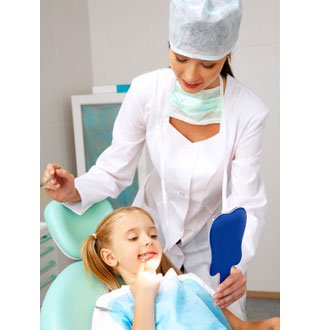
This design has the advantage of being able to be temporarily removed if necessary. A removable plate is used to straighten the teeth of children with minor anomalies in the dentition and correct the bite. Only a doctor can determine the duration of therapy. In most cases, it does not exceed 1.5-2 years.
Removable plates are orthodontic devices that are used to correct only malocclusions and uneven teeth. In addition, sometimes there is a problem with the whiteness of tooth enamel. A special plate with a whitening effect can eliminate it. The course of therapy using such devices is 14 days. But before use, you must seek help from a doctor.
Operating principle
Dental plates are a structure presented in the form of a metal arch, which is fixed to a plastic base. There are clasps along the edges for fixation. The principle of their influence is soft pressure, which is adjusted at certain intervals using a special screw. Temporarily tightening this element with a special key leads to expansion of the surface of the product. Thus, the load on the lower or upper jaw increases.
Since this orthodontic design is produced individually, the plastic base must be precisely adjusted to the surface of the gums. As a rule, wearing plates does not involve any discomfort. Little patients get used to such a device within a few days, and then live a normal life.
Based on the principle of influence, the following dental plates are distinguished:
- Single jawed. They are used for uneven dentition and individual teeth. Therapeutic effect is achieved due to the pressure adjusted by tightening the screws.
- With built-in pusher. Allows you to solve crooked teeth in the upper row. Positive effect achieved under pressure with a spring wire.
- With refractive arc. Solves protrusion of teeth in the front row.
- With an arched process. Eliminate anomalies of individual teeth in the upper and lower jaws. Positive result can be achieved by moving the tooth under the load of the process.
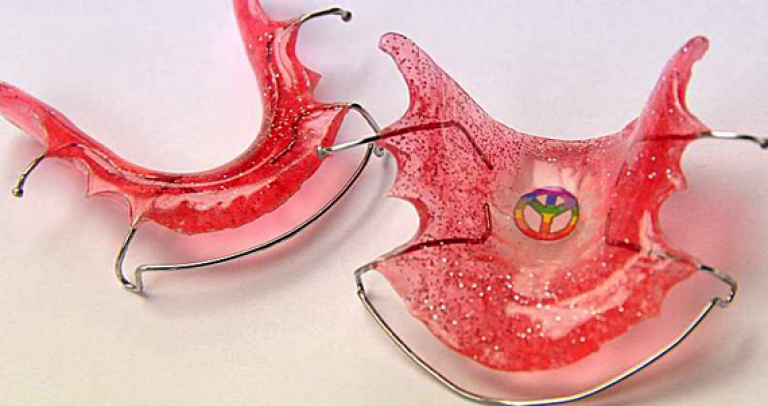
Positive and negative sides
Correcting bites with plates in adults and children has its own advantages and disadvantages. Let's look at the positive qualities first:
- Possibility to remove the device for a certain period. Thanks to this, a person can safely brush his teeth, eat, and also do various other manipulations.
- Caring for orthodontic structures is very simple. Even a child can cope with such work.
- The plate production process is carried out in the laboratory. The adult or child does not need to sit long time in the dentist's office.
TO negative qualities should include:
- Despite the fact that removing the plates allows you to solve problems such as normal eating and hygiene oral cavity, sometimes this leads to children losing the device. As a result, parents need to go to the dentist again and pay twice the money. In addition, the child may not lose the plate, but remove it often. This will disrupt the effectiveness of treatment, which is affected by the duration of wear.
- Compared to a brace system, a plate cannot move teeth. Its purpose is to hold teeth in a specific position.
- Sometimes the plate has to be removed for further installation of braces.
Nuances of wearing and care
In order for the wear of the plates to have maximum effectiveness, it is necessary to observe certain rules and nuances:
- The installation of a removable plate should be carried out not only in daytime, but also at night. If this condition is not met, the achieved effect will be lost.
- Products presented must be carefully maintained. To do this, it is important to maintain normal oral hygiene. Otherwise, you will not become the owner of a beautiful smile.
- The brushing process should be done using a personal toothbrush. The best option would be soft bristles.
- The use of special gels allows you to clean products already worn on your teeth. There are several types of gel. Some are allowed to be used daily. Another option is allowed to be used once a week, as deep cleansing is achieved.
- Every week it is necessary to immerse the products in a special cleaning concentrate. Leave overnight.
- When eating, the removable product should be removed, otherwise contamination may occur, which will lead to caries.
The difference between braces and plates
Even earlier, the products presented were considered the most suitable for eliminating uneven teeth. For this reason, plates were not installed at any age. Children whose age was older than 15-16 years were not suitable for this manipulation, since the treatment did not give the desired result. Today, the orthodontic devices presented can be placed on patients of any age. An expansion-type device can be installed to combat malocclusion in children, provided that the anomaly is minor. For patients who are 18 years of age or older, a braces system is installed, since the formation of teeth and bite has already taken place. Therefore, the choice of treatment device should be based on the age and severity of the abnormality.

Price
The price of the presented product consists of the cost of equipment and dentist work. Various dental centers set their own price for therapy, since there are different doctors and services. It is advisable to purchase a dental plate only if, during the diagnosis, a precise diagnosis has been made - crooked teeth or malocclusion.
The cost of production and installation of one record will be in the range of 15,000-20,000 rubles. Due to the fact that the therapeutic course includes a temporary change of product, the final price will be more expensive.
The topic of our discussion is dental plates. This is one of many existing methods bite correction, along with aligners, positioners, soft aligners of other types. In this article you will learn about what types of records there are, how effective they are and how much it costs to make them in different clinics. I am not going to criticize or praise any product, since the success of application is always individual.
What types of dental plates are there?
All correctional structures of this type are divided into two main types - removable and non-removable.
In the first case, the product is installed using special hooks that are fixed to the teeth. The plate itself is made of high-quality hypoallergenic plastic, and the frame and hooks are made of high-quality medical steel. The period of use is from one to two years.
Plus - the ability to remove it at night and while brushing your teeth. The downside is that you have to remember to put them on again. Self-discipline influences efficiency.
If the product is used to correct a child’s bite, parents will have to monitor this
The non-removable plate is more complex system. This is a metal arch and clasps that are attached to the teeth. You need to wear it for several years. From time to time you will need to visit the orthodontist for corrections.
The main difference between a removable and non-removable plate is cost. The more complex and specific the design, the more difficult the manufacturing and fitting, the more expensive it will be, accordingly.
Many people, even after consulting a doctor, have difficulty understanding how to wear dental plaques. They often take them off and forget. Of course, such treatment drags on for several years, and sometimes does not bring the desired result at all. Doctors cannot force us to follow orders. Therefore, effectiveness depends 100% on self-control.
When can I shoot?
- You are going to gnaw something, chew something. Obviously it will be difficult to do this with a record.
- When you brush your teeth (this is an average of 2-3 minutes), the correction product is also allowed to be put aside.
Manufacturing and installation
Creating a plate and adjusting it is a complex procedure. Each patient needs to undergo an examination, an X-ray of the jaw and an impression. A model is made from plaster, which is tried on and modified. Only after the model accurately follows the line of the gums and teeth is a finished plastic product made from it.
It is not always possible to fit the record perfectly the first time. After spending a day with the plates, the person returns to the doctor and talks about his feelings. You can always tighten/loosen the screw and adjust it. It's not at all difficult to do this.
Hygiene
The record itself requires care. Moreover, carry out simple procedures needed regularly. Bacterial plaque that forms on the teeth also ends up on the surface of the product.
Special gels are produced - one for daily cleaning, the second for deep cleaning (once a week) and solutions into which a plate is dipped to kill bacteria.

Sometimes the owner can even detect ( hard coating) on a plastic surface. Here you will have to spend more time and money, and take the record to professional cleaning. Special solutions work wonders.
Use for cleaning at home regular brush with soft bristles so as not to damage anything. Any excess pressure causes harm.
The screw must be moistened daily with machine oil. After this, it should be scrolled once in both directions.
There are no other features or difficulties. In just three or four days, these procedures will become your habit and will not cause any difficulties.
Records for children
Any doctor will tell you that the effectiveness of orthodontic treatment directly depends on when the correction begins. Therefore, dental plates for children will bring much faster results than the same manipulations with a forty-year-old man. The teeth of a child and even a fifteen-year-old teenager are much more pliable than after ten to twenty years.
Aesthetic dentistry achieved significant success in recent years thirty. But even it is powerless in the face of complex defects if patients do not want to have permanent structures installed.
Often parents bring in a child whose teeth grow at unimaginable angles, or with a deep bite. And they want him to be given some kind of removable mouthguard. They say, let him sit at school all day without anything, and then, at home, wear something “prettier.”
Parents can be understood. They worry about the psyche of children who may be teased by their peers at school. But if we're talking about about at least minimal efficiency in difficult cases, you can’t do without constant wearing special devices.
Much depends on the professionalism of the specialist to whom young patients are treated. After all, he needs to create an ideal model that can correct the defect as quickly as possible. short term.
It is logical that fathers and mothers want to see the effect of treatment quickly, but it will appear in six months to a year. It will have to be secured with mouthguards and maintained throughout life. After all, the dentition will expand with age. Therefore, there is no “once and for all”.
If a child wears the plates for a year or two, parents will have to get used to the idea that they will need to devote 365-730 days to constant monitoring:
- Check whether it is worn;
- How often does he brush his teeth and the record itself?
- Does it take it off before bed (it’s better not to take it off if possible;
- Also, don’t forget to put a drop of oil on the screw and regularly adjust the product to suit the child’s changing bite.
We will have to explain to children why they need an uncomfortable thing in their mouth, and why they should not hide it in their pocket when going to school.
Correction in adult patients
Does it make sense to put plates on the teeth of adults? In fact, it depends entirely on the patient himself. There are never two identical people and identical treatment cases in all respects. Even with one type of defect, two different people They get far more than just the same results. There are statistics, but even they cannot serve as a guarantee or a reason for refusal.
As mentioned above, it is more effective to start correcting bites with plates in childhood or adolescence. During this period (especially with baby teeth), treatment proceeds faster. The results become noticeable earlier.
Adults are immediately told two things:
- Removable structures are unlikely to be used;
- If the defect is serious, it is better to get braces.
For minor defects, you may be given permanent braces, and they will align the teeth with high probability.
Plates are also worn after braces. This is a means of securing the result, which is called a retainer. It does not allow the dentition to shift or return to its original position (the one it had before treatment). This procedure is mandatory for everyone. If the doctor did not tell you about this, or did not suggest it, then you should doubt his competence.
Without a retainer, you will have to put your braces back on as it may start to develop in a few months. reverse process, which will need to be stopped. After carrying glands in your mouth for a couple of years in vain, you will understand what despair is. Therefore, it is better to do everything right at once.
There is only one piece of advice here - don’t skimp on yourself and go to a good specialist. There are not many of them, there is a queue. But you will be sure that you will not have to re-treat your teeth.
Plates on teeth - effectiveness. Reality and fiction
There are many photos “before” and “after” of dental plate treatment on the Internet. If you don’t understand anything about dentistry or are simply inattentive, then you can miss one small detail - 90% of such pictures on the Internet are banal photo manipulations. Often, instead of a real result, we are offered a photograph edited in Photoshop or even a photograph of the teeth of a completely different person.
If you read stories on review sites, you get conflicting opinions. But you shouldn’t immediately stigmatize the technique or doctors. The reason for failure is always banal. It rests either on the lack of discipline, or on the use of a obviously inappropriate correctional structure. After all, the orthodontist cannot force the patient to pay for specific dental plates. Some people are looking for “cheaper”, others “more beautiful”. The results of this attitude to the procedure are always the same.

Let's sum it up
So, what did we understand from what we read?
- Plates are most effective for correcting malocclusion in children;
If a child's teeth grow unevenly, these days it will not be an insoluble problem. Techniques have now been developed to correct the position of teeth from a very early age. One of them is the installation of leveling plates.

Peculiarities
Alignment plates, also called retainers or braces, are used to correct a child's misaligned bite as it begins to develop. They are recommended for isolated pathologies, and are also prescribed after the use of braces to consolidate their effect.
Individual models of plates differ in their structure, but all such orthodontic devices have the same basic elements - a plate, a wire (arc) and a fastener. For the plate itself, soft or medium-hard plastic is used different color. It is curved according to the shape of the child's palate. Main function Such plastic is used to hold the arc, made of titanium-nickel alloy.
It is the arc that provides the leveling effect, since it has “memory” - the initially adopted shape of the wire does not change during chewing load.
It continuously affects the incorrectly positioned crowns of the teeth and causes them to gradually shift. And since the force of impact is not too great, the arc does not harm the root system of the teeth. The thickness of the wire may vary depending on the situation.
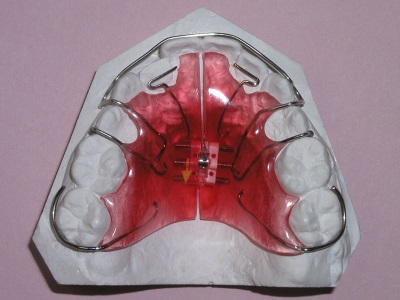 Plates will help cope with improperly growing teeth when the bite is just forming
Plates will help cope with improperly growing teeth when the bite is just forming
The fastening in the plates is represented by a special mechanism in the base, equipped with a small screwdriver. In some plates, the design includes additional elements, such as built-in activators, which are regularly tightened to keep the archwire tight.
Kinds
All plates used in children are divided into:
- Removable. This is the most common type of plates, secured to the teeth with hooks. They are worn daily but removed periodically. The main advantages of such designs are ease of use and low price. However, a removable plate can only be used when aligning one tooth, provided that it is slightly displaced. Depending on the structural features and purpose, removable plates can be single-jawed, with an arm-shaped process, with an active spring pusher, with a retraction arc, and others.
- Fixed. Such plates are usually recommended for correcting a group of teeth, which requires long-term exposure. Their design contains locks through which the arc is passed. They are needed to periodically tighten the plate so that the crowns remain under the required pressure. Due to the presence of locks, the non-removable plate is more expensive.
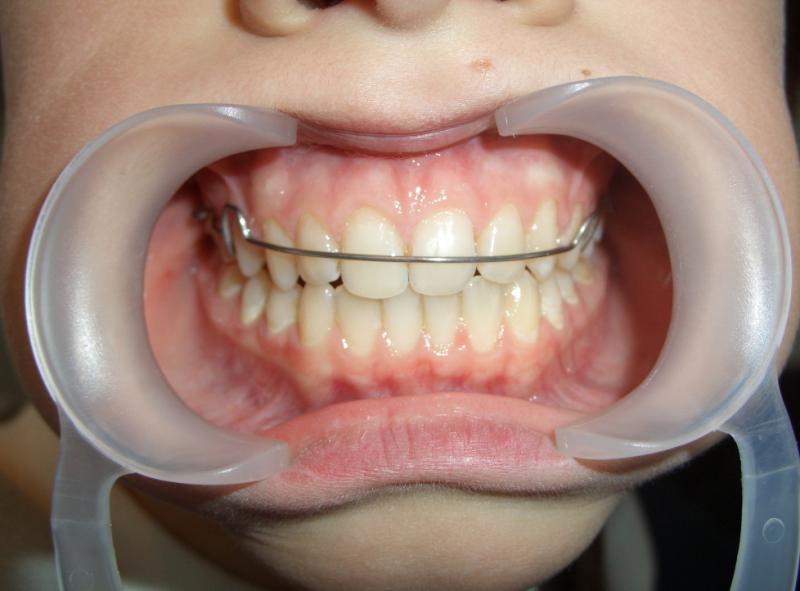
 Removable plates are effective when you need to straighten one tooth
Removable plates are effective when you need to straighten one tooth
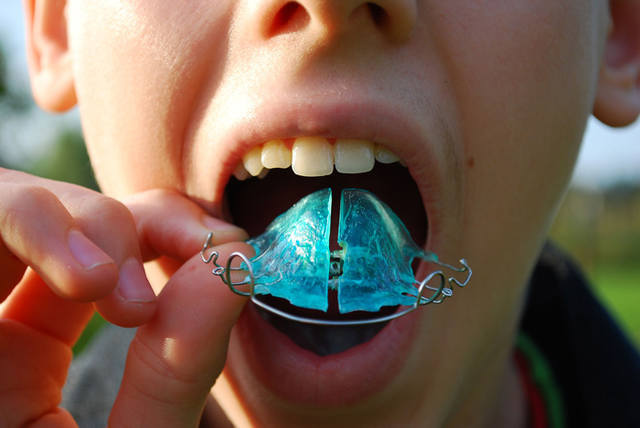
Indications
Plates are prescribed for:
- Displacement of one tooth.
- Incorrect placement of several teeth.
- Rare arrangement of dental crowns.
- Problems with the development of the jaw bones.
- Slowing or increasing jaw growth.
- Narrowing of the palate.
- Desire to prevent tooth movement after using braces.
Look next video about plates for teeth straightening.
Contraindications
Leveling plates are not used if the child has:
- Periodontitis has developed.
- You are allergic to the components from which the device is made.
- Have illnesses respiratory tract.
- There are teeth affected by caries.
Bite correction
Most frequent indication the use of leveling plates is caused by an incorrect primary or mixed bite. This appointment is justified, because with such a bite, the position of the teeth is quite easy to correct and does not require a large load.
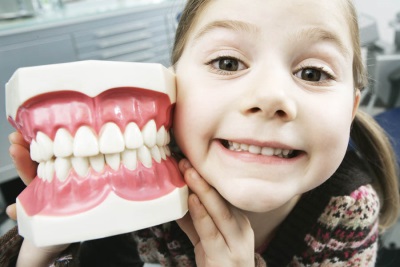 If you install the plate under excessive pressure, there is a risk of loss baby tooth. Therefore, the dentist must supervise the installation of the plates
If you install the plate under excessive pressure, there is a risk of loss baby tooth. Therefore, the dentist must supervise the installation of the plates
In this case, only the dentist should decide whether a plate is needed and also ensure its correct installation. Since the root system of primary teeth is less strong, there is a risk of their loss due to excessive pressure on the teeth.
Care
Although the leveling plates are made using flexible plastic and hardened metal, improper care of the device can cause it to break. Here's how to care for your braces:
- Clean the plate daily (at least once) with a soft toothbrush and regular toothpaste or special gel.
- The staples are treated weekly with a solution that provides deep disinfection. To do this, the plate is placed in the solution overnight.
- The plate should be removed before each meal.
- Before each installation, the plate is washed with warm boiled water.
- A special container is used to store the structure.
- If the plate breaks, it should be taken to a doctor immediately.
- To prevent the rotary screw from jamming, it is recommended to lubricate it with a drop of oil.
What to install - plates or braces?
IN early age Orthodontists often recommend the installation of plates, and braces are used to correct teeth in children over 12-14 years of age.
 Braces are not recommended for children under 12-14 years of age
Braces are not recommended for children under 12-14 years of age
Using braces at an earlier age can affect the development of the skull bones.
Record prices
Installing a leveling plate is much cheaper than using a bracket system - about 2-3 times. To find out the answer to the question “how much does it cost to put records?”, you need to consider various factors. The cost of the device is influenced by the design features of the plate, its materials and the level of the clinic in which the staples will be installed.
On average, for an ordinary plate of standard color made of medium-hard plastic without additional parts, you need to pay up to 10 thousand rubles. If the plastic is colored or softer, the cost will increase by 2 thousand or more.
Plates with one screw cost an average of 9 thousand rubles, and each additional screw increases the price by 1-2 thousand rubles. If you need to install a special tongue flap on the device, this will add 500-1500 rubles to the cost of the plate. Devices that help correct the situation chewing teeth, on average cost 14 thousand rubles.
Installation process
- The production of the plate must be strictly individual. First, the child is examined by an orthodontist to identify problems, and also sends the little patient for an x-ray. Based on the examination, the doctor selects the type of plate and tells the patient and his parents about the principles of operation of the device.
- After taking a wax impression of the child's teeth, it is used to create a plaster model, on the basis of which a plate is made. The second visit to the doctor involves installation and adjustment of the structure, which takes approximately 10 minutes.
- Next, the doctor will inform the parents about the specifics of care, the need to adjust the arch (if provided), as well as the duration of use of the plates. On average, such a device is worn for about 2 years. If the device is removable, it is recommended to wear it at least 21 hours a day, removing it only for brushing teeth and eating.
 The plates are made individually for each child based on an impression
The plates are made individually for each child based on an impression
As with all orthodontic appliances, the leveling plates take some getting used to. In the first days, due to their use, the child may experience discomfort and sometimes even painful sensations. Speech may be impaired and salivation may increase. As a rule, all such adaptation symptoms disappear within 3-7 days after installation.
Since the removable plate is a foreign device, the child will have the desire to remove it, so parents will have to monitor this point. It should be explained to the child that for the alignment to be effective, the plate should be worn most of the day. If you constantly remove it, the results will appear more slowly, which is why you will have to walk with the device longer.
It is also important to pay great attention to caring for the child’s oral cavity. The child must brush his teeth twice a day, removing the plate for this period, and also clean the structure itself.
Plates for straightening teeth in children are the simplest and at the same time quite effective designs designed for the correction of dental defects from the age of 3 years. These devices not only help in solving orthodontic problems, but also help the child get rid of bad habits(for example, thumb sucking, lip biting), and also have an indirect positive effect on the development of diction and the formation of general speech skills.
Plates for straightening teeth
Orthodontic plates designed to straighten teeth in children are removable. Such plates are small-sized structures made of hypoallergenic plastic, manufactured using technology that completely eliminates the presence of chemical impurities harmful to health. They consist of a plastic base that follows the contours of the palate and a metal wire (arch) that fixes the teeth in a certain position, covering them both from the outside and from the outside. inside. The moderately rigid and durable base of the plate can have a color and pattern chosen by the child himself.
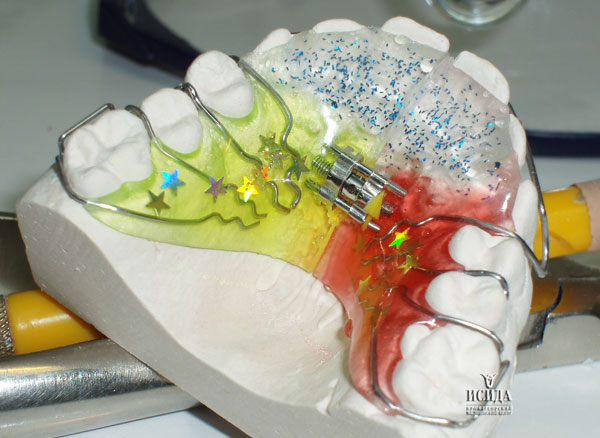
Removable plates are attached to children's teeth using metal hooks. For more rigid fixation of the orthodontic structure, additional screws or springs may be included. The plates are easily installed on both the top and the lower jaw. On average, the duration of wearing them is 1.5-2 years. The main advantage of these plates for straightening teeth is the possibility of regular removal.
Indications for the use of orthodontic plates
There are several indications for wearing orthodontic plates in children to correct the position of teeth:
- the presence of diastemas and trema (gaps between dental units);
- irregular shape, narrowness of the jaw bone;
- the need to move and prevent crowding of teeth;
- correction of the width of the palate;
- prevention of relapses of malocclusion.
- In addition, plates are placed on the teeth, helping to keep them in correct position, prevent displacement of the dentition in an undesirable direction, depending on the nature of the anomaly, stimulate or inhibit jaw growth, and can also replace a missing tooth unit.
Prices for dental plates
How to install removable plates
Removable plates for teeth are made individually. Previously little patient do an x-ray maxillofacial area and perform diagnostic dental impressions. Then, after creating control plaster models, the correctness of their shape is assessed and the plate is directly produced.
The removable device, manufactured using individual technology, is precisely fixed in the physiologically correct position and ideally fits the dental contour. The child can wear it throughout the entire treatment. The first installation of plates for teeth correction lasts no more than 10 minutes, of which most of the time is devoted to the final adjustment. On average, the adaptation period for children to dental plates is 3-5 days.
In this situation, it is very important that the baby’s parents understand the importance and seriousness of constantly wearing the plate on the teeth and control this process. The plates are only allowed to be removed before bedtime and during meals. Only in this case will the therapeutic effect of wearing them be truly complete.
Caring for teeth straightening plates
Due to the fact that children's teeth are sensitive to caries, they are very important point When wearing a plate, which can become an excellent place for the accumulation of plaque with bacteria living in it, proper hygienic care is required. To avoid contamination, devices should be removed before eating and thoroughly rinsed under running cold water before reattaching.

Cleaning dental plaques is done using a toothbrush with soft bristles and special gels for everyday care. In addition, once a week it is recommended to immerse the structure overnight in a cleaning concentrate, and also use a deep cleaning gel as necessary.
Benefits of Dental Plates
Possibility of unhindered removal. If necessary, the plate can be easily removed without causing discomfort to the little patient while eating and hygiene care behind the oral cavity. This is especially important for young children who do not yet fully understand the importance of keeping their teeth clean.
Safety. Made from hypoallergenic material, the plates practically do not cause development allergic reactions and do not injure the delicate mucous membranes of the child’s oral cavity.
Gentle effect. The dental plate for teeth correction can be easily and painlessly removed and put on, ensuring comfortable wearing.
Possibility to get rid of dental anomalies in the early childhood(from 3 years old). This type of orthodontic design makes it possible to correct a number of not too serious bite defects and straighten individual teeth in the youngest patients.
Fast production. Removable dental plates require less patient involvement in the manufacturing process and are produced much more quickly than fixed dentofacial devices.
Cost of records
The average price of a teeth straightening plate is 2-3 times lower than the cost of the most inexpensive braces. When forming it, the following factors are taken into account:
- the nature of the anomaly in the location of the teeth;
- design features of the plate;
- material of manufacture;
- number of replacement plates required for carrying out full course treatment.
To make an appointment with a pediatric orthodontist dental clinic"Martinka" and to clarify the information you are interested in about correcting the bite with plates to correct the position of the teeth, call our consultants at the number indicated in the "" section.
Irina, 32 years old
Question: Hello! I'm wondering if the plates pose a danger during a child's active play? Can they injure the mouth or throat?
Answer: The plate is securely attached to the teeth, and you can remove it only after performing certain manipulations. The material from which the plates are made is resistant to cracking and chipping, and the edges are processed in such a way as not to injure the mucous membranes of the mouth. Therefore, the plates do not need to be removed while the child is busy active games. Another question is if this contact types sports (hockey, wrestling, football, etc.) or acrobatics. In this case, the plates will need to be removed before classes.
Yana, 26 years old
Question: Hello. Tell me, is it allowed to wear plates if the child has not yet reached the age of 3, but at the same time all his milk teeth have erupted?
Answer: For any malocclusion or formation of the jaw skeleton, treatment should begin as early as possible. Therefore, the age of the child is a relative criterion. In each individual case, the orthodontist makes a decision on an individual basis.Sergey, 40 years old
Question: Hello! How often does a child need to change the plate and how can one understand that it is time for a replacement?
Answer: At long-term treatment malocclusion or correction of the formation of the jaw bones, the plate requires periodic replacement. This is due to the growth of the child (and, accordingly, the growth of the facial bones and jaws). Each child has individual growth rates and progress in treatment, which are assessed by the attending physician. Therefore, an independent decision to replace the plate cannot be made by parents: their task is only to monitor wearing it correctly plate, caring for it and timely visits to the orthodontist.Inna, 30 years old
Question: Is it possible to stop wearing the plate if the child is sick with ARVI? And can the plate cause infectious diseases?
Answer: At proper care behind the plate it cannot be a source of infection. During the child's illness, you can temporarily stop wearing the plate if the cause of the illness is respiratory tract infections or inflammatory processes in the oral cavity.
Vera, 37 years old
Question: Good afternoon. What is maximum duration course of treatment using wearing a plate and up to what age of the child is such treatment effective?
Answer: There is no such thing as a maximum or minimum course duration. The orthodontist monitors the effectiveness of treatment and evaluates progress in the state of occlusion, taking into account individual characteristics patient. As bite defects are eliminated, it can be reduced daily time wearing a plate or, conversely, increased if the progress is insignificant. Wearing plates is effective until the formation of the jaw skeleton has ceased. At the end of this process - at the age of 13-20 years - other methods of treating malocclusions are recommended.Plates for teeth straightening are best option for those who do not want to put up with an incorrect bite and uneven, crooked teeth, but cannot wear braces. Initially similar orthopedic structures used to treat malocclusions and less-than-ideal dentition in children. But today they are successfully used for adults.
What is it, what is the difference from braces, how to properly care for the plates - below.
Plates for teeth straightening - description and types
Plates for teeth straightening are orthopedic structures that are a modern alternative to braces. The plate consists of an arch covering several teeth and a palatal fixing part. Providing constant pressure on the teeth, they contribute to their gradual alignment and displacement in a given direction.
At their cost, plates are much more affordable than braces and are much more comfortable and safer to use. Based on the method of fixation, the plates can be divided into removable and non-removable. 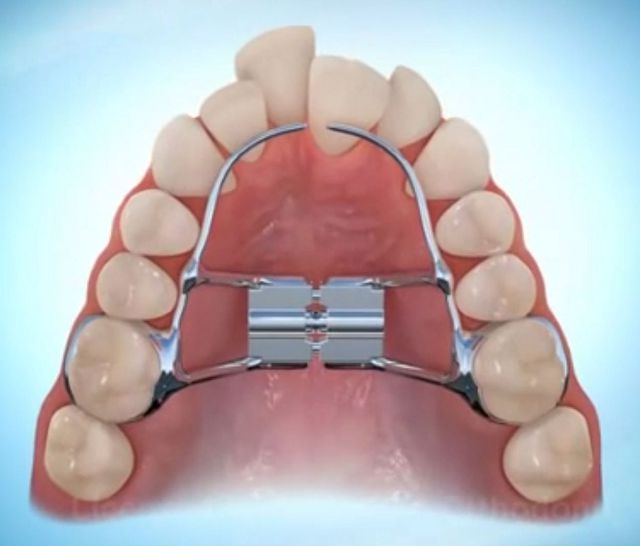
- Fixed structures for straightening teeth in adults and children are very similar to braces. They are a system of locks that are attached to outside teeth. A metal arc is passed through these locks. By changing its position, you can adjust the force of pressure on uneven teeth and thus correct dental defects. To obtain the desired effect, lasting and noticeable, you need to wear non-removable plates on average for two years - in children this period may be less, in adults in severe cases with severe curvatures it reaches 3-3.5 years.
- Removable structures are made of high-quality plastic; such dentures are attached to the teeth using metal hooks and may additionally have screws, springs and brackets to enhance the leveling effect on severely crooked teeth. Removable plates are mainly used to straighten teeth in children and adolescents - they are simpler and more convenient to use than fixed structures. They should be worn for a maximum of 1.5 years, in some cases the period may be extended for medical reasons.
Removable products will cost more than non-removable ones. But they can be removed independently when required, and they are practically invisible in the oral cavity to others.
Advice: removable plates can correct only minor defects in the dentition, which is why they are used in most cases in pediatric dentistry. For adults, whose hard dental tissues are already formed and dense, such structures can hardly help effectively.
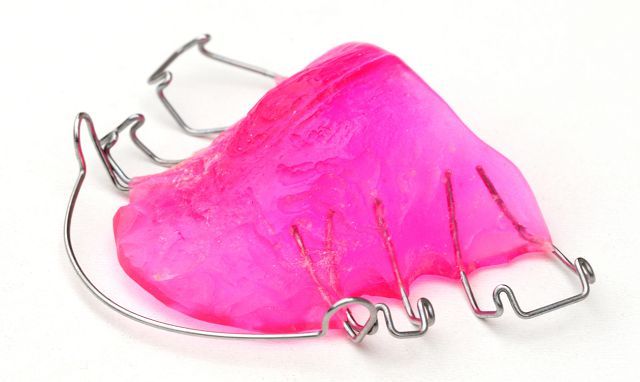
How plates are installed to straighten teeth
Plates are always made individually. The process includes the following steps:
- X-ray. It is necessary to take a picture of the jaws so that the doctor gets a clear idea of the location of the teeth and their defects.
- Taking an impression. The dentist makes a cast of the jaw, then transfers it to the laboratory to the technologist, and he makes a plaster model from it.
- Manufacturing. Based on the model, a plate is made of high-quality plastic, which is used to straighten the teeth for the entire period of treatment.
The design accurately follows the relief of the palate and gums, and the metal arch is located in such a way as to have maximum impact on uneven teeth in children.
Which is better – braces or plates?
 Once again, it is worth noting that plates are effective only if you need to correct minor crooked teeth in children. Even in adolescents aged 15-16 years, these orthopedic structures no longer have the necessary effect - therefore, at this age, the installation of braces is recommended.
Once again, it is worth noting that plates are effective only if you need to correct minor crooked teeth in children. Even in adolescents aged 15-16 years, these orthopedic structures no longer have the necessary effect - therefore, at this age, the installation of braces is recommended.
It is impossible to say which is better - plates or braces, since they work differently and are prescribed in situations of different complexity. If one or two teeth are positioned incorrectly and the curvatures are insignificant, then you can get by with plastic plates even in mature age. If the problems are serious, then at the age of 10-12 it is recommended to install braces.
Features of using plates for teeth straightening
Since these structures are used primarily to correct malocclusion and crooked teeth in children, control over the orthodontic treatment process should be exercised by parents. 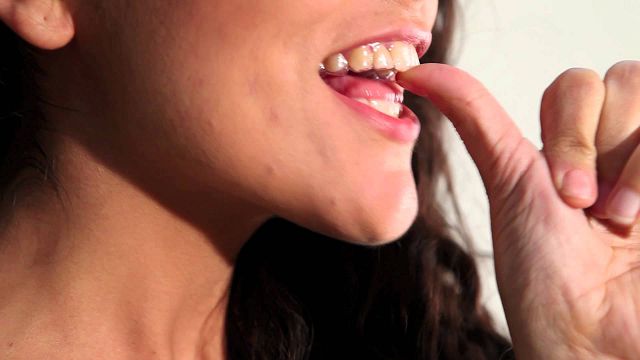
- The plates must be worn at night, otherwise they will not have the desired effect and the process of correcting the bite and straightening the teeth in children will take a long time. long months and years.
- During the treatment period, children's teeth must be looked after especially carefully, since when wearing plates, dental plaque is formed and deposited on their surface especially intensively. If caries develops, treatment will lose its meaning - the teeth will become straight, but at the same time they will be ugly and non-functional.
- To care for teeth straightening plates in children, use only special means. These are two types of gels, one of which is intended for daily care, and the other for deep cleansing once a week.
- If the structure is removed at night, it must be immersed in a special disinfectant and cleaning solution.
- Products should only be cleaned with a personal brush with soft bristles.
- The plates must be removed before eating - this is the only way they will maintain their integrity and last a long time.
In most cases, structures are designed in such a way that they need to be tightened. Ideally, this should be done by a doctor after examining the patient’s oral cavity and assessing the changes that have occurred. Typically, the plates need to be adjusted every six months. But if a doctor is temporarily unavailable, you can correct the plates on children’s teeth yourself.
Almost all modern products are equipped with a screw, for which a special key is provided. The key is inserted into the hole on the plate; one turn must be made in the direction of the arrow on the base of the plate. The palatal part of the structure will thus expand and the pressure on the teeth will change. You can return the plate to its original position by turning the key in the opposite direction.
Sometimes plates are used to secure achieved effect after using braces. In any case, this is a very affordable and most comfortable way to make a smile, if not ideal, then as close to it as possible.
Quality dentistry Aesthetica in Moscow.
